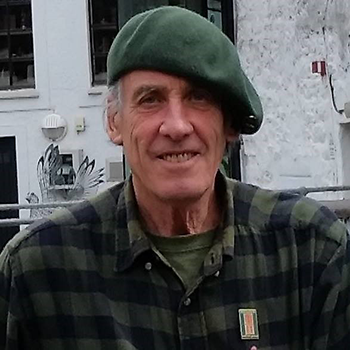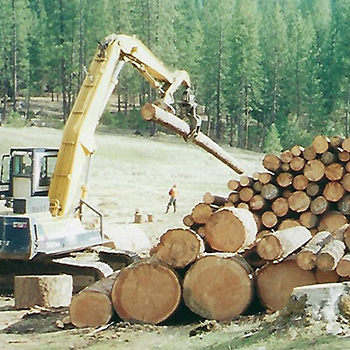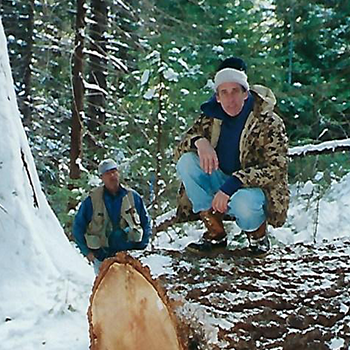By Denise Seghesio Levine | (July 2019)
“Grandad would come home from work in a three-piece suit. I can remember him standing and talking to someone, and he would reach in his pocket and pull out a pair of pruners and start pruning whatever shrub, plant or tree was around him needing pruning at the time.”
I had an opportunity to chat with one of our newer members, Robert (Rob) Menzies back in December and asked him about his background in plants and forestry. Rob recounted some of his earliest memories and influences. His grandad in the family gardens, his dad in the family forests.
When he was 12 years old, Rob’s dad gave him his first small new McCulloch chainsaw. His love of working with wood developed and eventually he left his home and businesses in the Bay Area to move north to the wilderness and begin building his log cabins by hand. Rob treasures the experience of knowing his trees, choosing them, knowing their soul, harvesting, drying, milling and eventually building boxes, garden beds and homes. Using the gifts of nature and his hands is one of his greatest joys.
Rob has traveled extensively and acknowledges having a botanical name has not hurt his career and has certainly increased his international botany, ethnobotany and forestry opportunities. In 1791 Sir Archibald Menzies, Botanist and Scotsman, journeyed on three of Captain Vancouver’s North American expeditions, identifying, cataloguing more than 2,300 species of Northwest Pacific plants and trees. Pacific Madrone (Arbutus Menziesii), Douglas fir (Pseudotsuga Menziesii), and many other plants and trees we live with every day in our gardens were noted and named for Sir Archy.
Rob’s adventures in botany have taken him to gardens and forests in China, Korea, Central America and beyond. More recently Rob spent several summers at the Menzies (Mingus) Castle in Scotland, helping to restore the gardens of his ancestors.
Back at the Ranch, Rob’s dad encouraged him to explore a harvest on their inholding property in the Trinity Alps in 1999-2000. He used to say, “Trees are like tomatoes. You either harvest them, or give them to the birds.”
Rob had his own criteria for harvesting. The first cruise in 1961 determined there was prime crown virgin timber. The Menzies family had never harvested the land, an inholding, completely surrounded by government land. Accessible for years only by a four-mile hike, mule or horseback ride, the beauty and solitude of the land had always been appreciated and loved.
The first cut dealt with the view corridor...no cuts visible from the porch, and other trees were marked to save as well. Second cut was ‘sustainable’ pockets…the upper part of the property supported a more extensive harvest. In all, more than 1.2M log feet of wood came off the ranch. Because of the inaccessibility, all the logs were helicoptered out.
One million log feet went to Boise Cascade. It had been so long since the mill had such large trees, Boise Cascade had to retool 32 foot blades that had been in storage for 15 years. Eighty-eight trees at 16 feet had diameters of six feet or more and those took the BIG blades. Rob and his RPF visited Boise Cascade witnessing the mills after they were retooled and the ranch’s logs were ready to mill.
Fir went to Timber Forest Products in Yreka and cedar went to Roseburg. Another part of Rob’s criteria for the harvest was that the money stay as local as possible, so he was pleased 18 local logging trucks a day made the trip to the mill with never more than six logs on the truck at a time.
Within one month improvement in the stands was visible, and now harvested 18 years ago…it is difficult to discern the forest was logged at all.
After living in the wilderness for five years and completing the harvest, Rob’s property became a demonstration area for the Forest Service and Cal Fire, birthed his Native Nursery and provided 60 varieties of conifers.
Rob identified a dozen endemic and indigenous conifers that are native just to that area, including Shasta Red Fir, Duck Pine, Menzies Weeping blue Fir (a hybrid of Mother Nature) Foxtail pine…and more.
Over the years, Rob’s work has expanded as he developed his New Vegetative Management program… NVM looks at a harvest or other project in a big picture and seizes the opportunity in disruption. NVM teaches and encourages a management style that values the economic opportunity of LGS (Little Green Stuff). Little green stuff is small plant material that is usually undervalued and disregarded but could have value in another setting.
In one of Rob’s projects, a 1,000 yard road cut yielded more than 200 small fern plants, polystichum and sword fern Woodwardia. Both ferns valuable in the landscape, this gleaning yielded $6,000 worth of nursery material, which is how Rob’s native nursery was born.
I would liken Rob’s New Vegetative Management in its quest to value plant material previously unvalued, to the SmallWood movement, evolving an appreciation of the value of previously unmarketable and unvalued biomass for a variety of uses. Rob hopes that when next you walk amongst the trees in your forest, you will note all the Little Green Stuff with more appreciative eyes.
Upcoming Events



